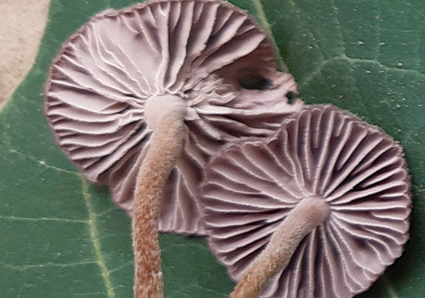Abstract
Several basidiomata of the genus Moniliophthora were found on plant debris, from the bed of the Indus River, Kot Addu, and an irrigated plantation in Chichawatni, Sahiwal, Pakistan. The morpho-anatomical examination along with phylogenetic analyses support the independent position of Moniliophthora purpurensis and M. capitata within the genus Moniliophthora. M. purpurensis is characterized, by an umbilicate and purplish pileus, bifurcate cheilocystidia, long pileal hairs, and lanceolate, lageniform-pedunculate caulocystidia. M. capitata is characterized by having a conical to applanate, dark brown stipe base, polymorphic caulocystidia, and the presence of a conical cap on terminal hair elements of pileus. We present the two new species with illustrated descriptions, molecular analyses, and comparison with morphologically similar or phylogenetically related species.
References
- Aime, M.C. & Phillips-Mora, W. (2005) The causal agents of witches’ broom and frosty pod rot of cacao (chocolate, Theobroma cacao) from a new lineage of Marasmiaceae. Mycologia 97: 1012–1022. https://doi.org/10.3852/mycologia.97.5.1012
- Antonín, V. & Noordeloos, M.E. (2010) A monograph of marasmioid and collybioid fungi in Europe. Germany: IHW Verlag Eching. 480 pp.
- Antonín, V., Ryoo, R., Ka, K.H. & Sou, H.D. (2014) Three new species of Crinipellis and one new variety of Moniliophthora (Basidiomycota, Marasmiaceae) described from the Republic of Korea. Phytotaxa 170: 86–102. https://doi.org/10.11646/phytotaxa.170.2.2
- Baig, S., Qazi, W., Akhtar, A.M., Waqar, M.M., Ammar, A., Gilani, H. & Mehmood, S.A. (2017) Above ground biomass estimation of Dalbergia sissoo forest plantation from dual-polarized ALOS-2 PALSAR data. Canadian Journal of Remote Sensing 43 (3): 297–308. https://doi.org/10.1080/07038992.2017.1330143
- Evans, H.C., Stalpers, J.A., Samson, R.A. & Benny, G.L. (1978) On the taxonomy of Monilia roreri, an important pathogen of Theobroma cacao in South America. Canadian Journal of Botany, 56: 2528–2532. https://doi.org/10.1139/b78-305
- Fatima, N. & Khalid, A.N. (2023) Xanthagaricus montgomeryensis sp. nov. (Agaricaceae, Agaricales) from Chichawatni Forest, Punjab Pakistan. Phytotaxa 594 (4): 256–266. https://doi.org/10.11646/phytotaxa.594.4.3
- Gardes, M. & Bruns, T.D. (1993) ITS primers with enhanced specificity for basidiomycetes‐application to the identification of mycorrhizae and rusts. Molecular Ecology 2 (2): 113–118. https://doi.org/10.1111/j.1365-294X.1993.tb00005.x
- Ge, Z.W., Yang, Z.L. & Vellinga, E.C. (2010) The genus Macrolepiota (Agaricaceae, Basidiomycota) in China. Fungal Diversity, 45 (1): 81–98. https://doi.org/10.1007/s13225-010-0062-0
- Hall, T.A. (1999) BioEdit: a user-friendly biological sequence alignment editor and analysis program for Windows 95/98/NT. In Nucleic acids symposium series, 41: 95–98.
- Haqnawaz, M., Niazi, A.R. & Khalid, A.N. (2023a) A study on the genus Candolleomyces (Agaricales: Psathyrellaceae) from Punjab, Pakistan. BMC microbiology 23 (1): 1–8. https://doi.org/10.1186/s12866-023-02938-2
- Haqnawaz, M., Niazi, A.R. & Khalid, A.N. (2023b) Two new species of Xanthagaricus from Punjab, Pakistan. Phytotaxa 583 (2): 163–173. https://doi.org/10.11646/phytotaxa.583.2.4
- Izhar, A., Asif, M., Niazi, A.R. & Khalid, A.N. (2022) A new crinipelloid species (Marasmiaceae, Agaricales) from Pakistan. Phytotaxa 538 (3): 197–212. https://doi.org/10.11646/phytotaxa.538.3.3
- Katoh, K. & Standley, D.M. (2013) MAFFT multiple sequence alignment software version 7: improvements in performance and usability. Molecular Biology and Evolution 30 (4): 772–780. https://doi.org/10.1093/molbev/mst010
- Kerekes, J. & Desjardin, D.E. (2009) A monograph of the genera Crinipellis and Moniliophthora from Southeast Asia including a molecular phylogeny of the nrITS region. Fungal Diversity 37 (101): 152.
- Miller, M.A., Pfeiffer, W. & Schwartz, T. (2010) Creating the CIPRES Science Gateway for inference of large phylogenetic trees, Gateway Computing Environments Workshop (GCE). New Orleans, LA, pp. 1–8. https://doi.org/10.1109/GCE.2010.5676129
- Munsell, A. (1994) Soil color charts. Revised edition. New York: Macbeth Division of Kollmorgen Instruments Corporation.
- Muhammad, Z.A., Javed, M.A., Yasin, G. & Ahmad, I. (2021) Effect of various agroforestry tree species on soil chemical properties of iirrigated tree plantation of Pakistan. Journal of Tropical Forestry and Environment 11 (01).
- Niveiro, N., Ramírez, N.A., Michlig, A., Lodge, D.J. & Aime, M.C. (2020) Studies of neotropical tree pathogens in Moniliophthora: a new species, M. mayarum, and new combinations for Crinipellis ticoi and C. brasiliensis. MycoKeys 66: 39. https://doi.org/10.3897/mycokeys.66.48711
- Singer, R. (1939) Phylogenie und Taxonomie der Agaricales. Schweizerische Zeitschrift für Pilzkunde 17: 63.
- Stamatakis, A. (2014) RAxML version 8: a tool for phylogenetic analysis and post–analysis of large phylogenies. Bioinformatics 30: 1312–1313. https://doi.org/10.1093/bioinformatics/btu033
- Stewart, R.R. (1972) An annotated catalogue of the vascular plants of West Pakistan and Kashmir. In: Nasir, E. & Ali, S.I. (eds.) Flora of Pakistan. Karachi: Fakhri Printing Press.
- Vellinga, E.C. (2001) Agaricaceae. In: Noordeloos, M.E., Kuyper, T.W. & Vellinga, E.C. (eds.) Flora Agaricina Neerlandica 5. Rotterdam: A.A. Balkema Publishers, 220 pp.
- White, T.J., Bruns, T., Lee, S.J.W.T. & Taylor, J. (1990) Amplification and direct sequencing of fungal ribosomal RNA genes for phylogenetics. PCR protocols: a guide to methods and applications 18 (1): 315–322. https://doi.org/10.1016/B978-0-12-372180-8.50042-1


